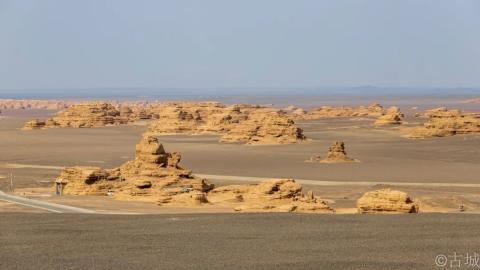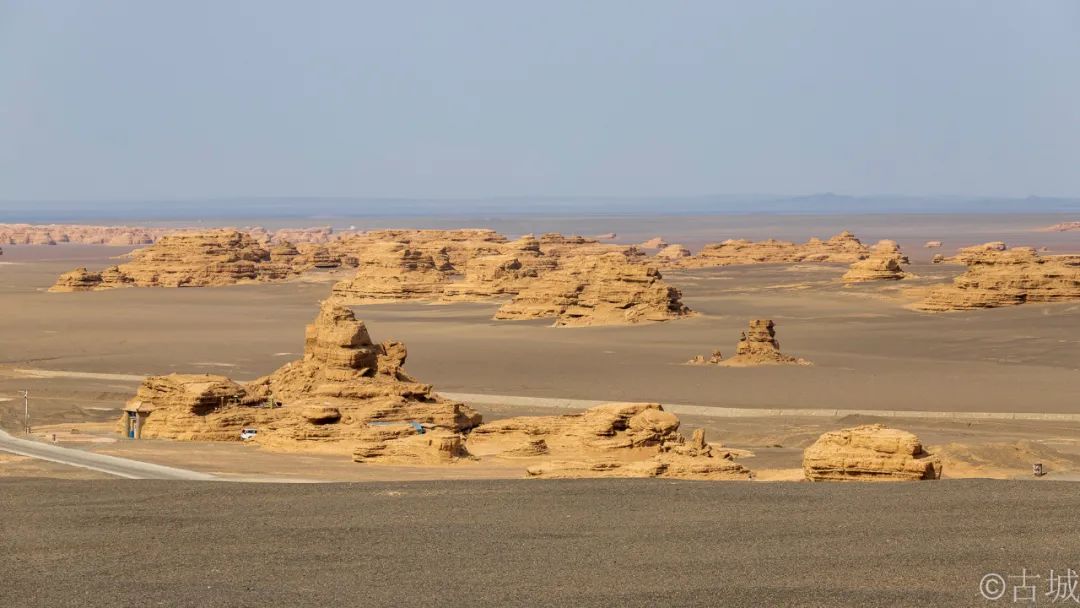
Day11 Dunhuang Yadan and Yumen Pass
I visited the Mogao Grottoes for two days in a row. Today I will take a day off and go to Yumen Pass.
Along the way we first arrived at Dunhuang Yadan Scenic Area.



The view is not bad.

Golden Lion Welcome

Sphinx



Peacock Yuli


West Sea Fleet

Then visit the Yumenguan Scenic Area.
Yumen Pass was first built when Emperor Wu of the Han Dynasty opened the road to the Western Regions and established the four counties of Hexi. It was named because jade was imported from the Western Regions through this route. The Yumenguan site is located on the south bank of the Shule River at the westernmost end of the Hexi Corridor, in a natural geographical environment composed of Gobi, desert, rivers and lakes. It faces the Beishan Mountains in the north, echoes the Qilian Mountains in the south, is about 90 kilometers away from Dunhuang City in the southeast, and is located in the west. It is about 150 kilometers away from the eastern edge of Lop Nur. This area has a landmark status as a geographical boundary between east and west traffic, and has been an important passage for east and west traffic since ancient times.
The currently recognized Yumenguan site is also called Xiaofangpan City and was built around 111 BC. It is the choke point of the Silk Road leading to the North Road of the Western Regions. The ruins of Guancheng are square, with loess walls 10 meters high, 3 meters wide at the top and 5 meters wide at the bottom. They are 24 meters long from east to west and 26.4 meters wide from north to south, covering an area of 633 square meters. There is one gate in the northwest.

Yumenguan poems on the doors and windows of the tourist rest area

Excavate cultural relics

Overlooking Yumen Pass (Xiaofangpancheng Ruins)

Dafangpan City Ruins (Hecang City)

An important munitions warehouse during the Wei and Jin Dynasties



Great Wall of Han Dynasty

It is built with layers of clay and tamarisk or reed branches.

In the distance is the Han Dynasty Peak Sui

The local area is preparing for the Yumenguan Poetry Week

Yumen Pass
Day12 Yulin Grottoes
In the morning, go to Yulin Grottoes. Due to the long distance, we went to Gobi Qingquan for dinner first.
Gobi Spring is an oasis in the vast Gobi. Surrounded by the barren Gobi mountains, only here there are springs, green spaces, floating reeds, ducks and white geese, which makes it feel like a paradise.


In the distance are barren mountains
Walking through the tall reed swamps, my eyes suddenly lit up, and a clear spring appeared in front of me.


What a magical place!
After the meal, we started to visit Yulin Grottoes. Yulin Grottoes, also known as Wanfo Gorge, Yulin Temple and Shangdongzi, is located 70 kilometers south of Guazhou County, Gansu Province. It is the sister cave of Dunhuang Mogao Grottoes and is also under the jurisdiction of the Dunhuang Academy. The cave is excavated on the upright east and west cliffs on both sides of the Yulin River Canyon. It is named after the forests of elm trees on the river banks. There is no written record of its founding date. Judging from the cave form and related inscriptions, it is believed to have been founded in the Northern Wei Dynasty before the Sui and Tang Dynasties. Judging from the style of the murals and the titles of visitors' inscriptions, we can see that the Tang, Five Dynasties, Song, Xixia, Yuan and Qing dynasties all had excavations and sculptures painted on them, and large-scale construction was carried out. There are 43 caves in the cave, with more than 250 painted sculptures preserved to this day, and the total area of murals is more than 5,000 square meters. Judging from the cave's form, expression content and artistic style, it is very similar to the Mogao Grottoes. It is a branch of the Mogao Grottoes art system.

Yulin River Canyon

Scenic area entrance

Yulin Temple Architecture



The trees are actually full of fruits!







We visited several caves from the Xixia, Mid-Tang, Five Dynasties and Song Dynasties. While understanding the historical and artistic characteristics of each cave, we also compared the similarities and differences with the Mogao Grottoes.
On the way back, we passed by the Son of the Earth sculpture and stopped to admire it.


Day13 Yangguan, West Thousand Buddha Caves
Arrive at Yangguan Scenic Area in the morning.
Yangguan, located 70 kilometers southwest of Dunhuang City, was first built during the period when Emperor Wu of the Western Han Dynasty "organized four counties and occupied two passes". It is a pass based on water and is dangerously close to Sichuan. It echoes the north and south of Yumen Pass. It is an important pass for the Han Dynasty to defend against the invasion of northwest nomads. It is also an important gateway from the Central Plains to the Western Regions and Central Asia on the Silk Road.

Zhang Qian sculpture

Yangguan Museum Exhibition


Antique buildings next to the bus stop

Encountering a little gecko in the desert


Then we visited the West Thousand Buddha Caves.
The West Thousand Buddhas Cave is located about 35 kilometers southwest of Dunhuang City. It is named because it is located west of the Mogao Grottoes (commonly known as the Thousand Buddhas Cave) and the ancient Dunhuang City. Excavated on the cliffs on the banks of the Dang River, there are 22 existing caves, 43 painted sculptures and more than 800 square meters of murals. They have gone through the Northern Wei, Western Wei, Northern Zhou, Sui, Tang, Five Dynasties, Song, Shazhou Uighur, Yuan and other dynasties. According to the Dunhuang posthumous documents hidden in Paris, the West Thousand Buddha Caves should have been excavated earlier than the Dunhuang Mogao Grottoes, and at the latest during the same period as the Mogao Grottoes. Whether it is an early grotto relic along the Silk Road or a model of cave art from the Northern Dynasties to the Sui and Tang, Uighur and Yuan dynasties, it not only maintains unity with the Mogao Grottoes, but also has its own unique historical and artistic value. Dunhuang is An important part of art.

We visited several caves dating from the Middle Tang Dynasty, Western Wei Dynasty and the Uighur Period, and saw the remains of the early grottoes.
At this point, our trip to Dunhuang Grottoes has come to a successful end. Through a short but intensive visit and study, I gained a relatively comprehensive and in-depth understanding of the Dunhuang Grottoes, and gained a lot. On the other hand, at this point, our travel plan for the Qinggan-Gansu Great Ring Route has been successfully completed. Next, we will start a new journey - a trip to Tibet.
